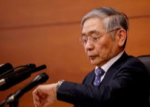The Fed's 50 bp rate hike is behind us. Another 50 bp hike is expected next month. The April employment report will do little to calm the anxiety about the "too tight" labor market. The decline in the participation rate was disappointing and this coupled with decline in Q1 productivity raies questions about the economy's non-inflationary speed limit. One of the fascinating things about the markets is that sometimes the cause take place after the effect. This is an interesting way to express the observation that investors anticipate, discount, futures scenarios. The dollar has been bought and fixed income sold on ideas that the Fed had taken a hawkish turn. The market now accepts that the Federal Reserve will bring it Fed funds target rate within the
Topics:
Marc Chandler considers the following as important: 4.) Marc to Market, 4) FX Trends, China, Featured, Federal Reserve, Interest rates, Japan, newsletter, trade
This could be interesting, too:
Nachrichten Ticker - www.finanzen.ch writes Die Performance der Kryptowährungen in KW 9: Das hat sich bei Bitcoin, Ether & Co. getan
Nachrichten Ticker - www.finanzen.ch writes Wer verbirgt sich hinter der Ethereum-Technologie?
Martin Hartmann writes Eine Analyse nach den Lehren von Milton Friedman
Marc Chandler writes March 2025 Monthly
The Fed's 50 bp rate hike is behind us. Another 50 bp hike is expected next month. The April employment report will do little to calm the anxiety about the "too tight" labor market. The decline in the participation rate was disappointing and this coupled with decline in Q1 productivity raies questions about the economy's non-inflationary speed limit.
One of the fascinating things about the markets is that sometimes the cause take place after the effect. This is an interesting way to express the observation that investors anticipate, discount, futures scenarios. The dollar has been bought and fixed income sold on ideas that the Fed had taken a hawkish turn. The market now accepts that the Federal Reserve will bring it Fed funds target rate within the range regarded as neutral before the end of the year. The hikes will be front-loaded with the next 50 bp hikes discounted for the next two meetings (June and July) and a strong leaning for the same in September (~66%). The balance sheet will begin shrinking next month at roughly the same pace that it peaked in the 2017-2019 experience before ramping up to twice the pace ($95 bln).
The week ahead is important because it may be the first signs that may be peak inflation is at hand. For the first time since April 2020, the headline reading of consumer prices and producer prices are expected to have fallen on a year-over-year basis. To be sure, it may not be a large move. By any measure price pressures remain elevated, but the direction is important.
It would be the first decline in headline CPI since last August. Core CPI will also likely ease as well. Recall that after the March report, many economists suggested that could be the high-water mark. - Producer prices, both the headline and core, are also expected to have softened a little. In April 2021, they had increased by 1.0%.
The composition of inflation may also be changing. Used car prices spurred a great deal of discussion last year. Prices are falling, like Powell suggested would happen when a year ago he drew attention to used car prices and lumber. The unusual rise in durable goods prices may be stalling. Shelter costs may pick up the slack.
One of the most important developments last week was the surge in the swaps market to price in a terminal Fed funds rate near 3.75%. Some, like the noted economist and former chief economist for the IMF, Kenneth Rogoff, believes that a considerably higher rate (5%) may be necessary to break the price spiral. However, most observers think that the economic conditions will warrant the end of the tightening cycle before then. Before the Fed gets the funds rate into the 3.75% area, the pockets of economic weakness, that already appear below the surface, will likely have broadened and deepened.
It is not just the domestic economy either. Headwinds will emerge globally. Although Europe's April PMI readings continue to show resilience, the deterioration of consumer and business confidence is alarming. Germany and French industrial output fell and by more than expected in March. National governments are cutting growth forecasts. The ECB has not moved. It continues to expand its balance sheet. The hawks are pushing for a July hike and the swaps market is taking the bait. We are less convinced that a consensus for this crystalized among ECB members. The Bank of England warned that the UK's output could contract by 1% in Q4 as the cost-of-living bites as energy price cap is lifted by another 40% in October. The BOE sees the economy contracting by 0.25% in 2023.
Japan does not report Q1 22 GDP until May 18, but that it contracted will not be a surprise given the extended Covid restrictions and the earthquake. It is old news in many respects. Arguably more important is that the recovery is already underway, and it will be aided by new stimulus measures. The preliminary April composite PMI rose for a second month, and if confirmed (May 9), it will stand at a four-month high.
Arguably, Japan's March current account figures due on May 12 will be noteworthy. First, the first trade surplus in five months is expected. To be sure though, the trade balance, as we have noted, does not drive the current account surplus. The capital flows associated with past investments, such as interest, dividends, profits, royalties, ad licensing fees, drive Japan's current account surplus.
Second, with the current account report, Japan also reports portfolio capital flows. The MOF publishes weekly figures, but the monthly figures include a country breakdown. Recall that the February report showed Japanese investors sold about JPY3.1 trillion (~$25 bln) of US sovereign bonds. Some observers have been emphasizing the Japanese selling of US Treasuries. Often the cost of hedging is cited. The general flattening of the US yield curve makes hedging the currency risk has more expensive and eats away at the yield advantage.
However, some Japanese life insurance companies like Sumitomo recently indicated they were going to increase the holdings of unhedged bonds. Even more challenging to the narrative is the fact that the US Treasury International Capital (TIC) report suggests a more nuanced story. In fact, the TIC report showed Japanese investors boosted their holdings of US Treasuries by $3.2 bln in February.
Sometimes the two data sets tell a similar story. The MOF figures showed Japanese investors sold about JPY143 bln (~$1.2 bln) in January. The TIC data showed the liquidation of slightly less than $1 bln. And it is not that the TIC data is biased toward less sales by Japanese investors. In December 2021, for example, the TIC data showed Japanese holdings of US Treasuries fell by about $24.6 bln. The MOF data showed divestment was half of that. More work needs to be done to understand the differences the two time series.
Chinese policies are often challenging to understand from the outside. It zero-Covid policy is a timely example. As the virus has mutated it is less deadly even with the China's home-grown vaccines, which reportedly are less efficient than Moderna and Pfizer's. The extreme lockdowns are crushing the economy. Consider that the composite PMI stands at 42.7 and 37.2 for the official measure and the Caixin version, respectively. Such readings are consistent with an outright economic contraction.
China reports several data points for April that will draw attention. First, China's reserves likely fell dramatically. It could be the largest drop since November 2016 when they dropped by $69 bln. The TIC data shows that China as reduced its Treasury holding in recent months by about $26 bln in between December 2021 and February 2022. However, the main culprit will likely be valuation. The dollar value of its foreign currency holdings (non-US bonds) fell as the greenback appreciated markedly last month. The euro fell by 4.7% and sterling was off 4.3%. The Australian dollar depreciated by 5.6% and the yen slid 6.2%. On top of that, bond prices tumbled in April.
Second, last month's lending figures will be reported. Aggregate lending soared by CNY4.6 trillion in March. This lifted the Q1 average of CNY4.0 trillion, up about 17% from the Q1 21 average and CNY2.6 trillion average for all last year. Seasonal considerations and the lockdowns warn that lending may have slow to around half of the March pace.
Third, China's trade balance is being distorted by the compression of demand due to the Covid response. Imports likely fell for the second consecutive month in April on a year-over-year basis. Exports have been erratic and probably slowed from the 14.7% year-over-year pace seen in March. China's trade surplus averaged $54.3 bln in Q1, which is up from about $36.2 bln average in the January-March period last year.
China's monthly trade surplus averaged $56.4 bln last year. It has practically doubled since 2018 (average monthly surplus $29.25 bln). When the yuan is appreciating against the dollar, it makes sense for corporates to convert their hard currency earnings to yuan quickly. But this is not the case now, and businesses do not need to be in hurry. Reports suggest the Biden administration is debating internally whether to remove some of the tariffs on Chinese goods, not as a boon for Beijing but to ease US inflation.
The US has an average of an extra 16% tariff on a little more than $500 bln of Chinese goods. Yet, the impact in US measured inflation would appears small. A recent report from the Peterson Institute for International Economics calculated that a two-percentage point cut in the average tariff on the $2.8 trillion of goods the US imports could shave a little more than one percentage points off GDP. It is unlikely to be a linear process, but imports from China account for about 18% of US import. A two-percentage point cut the tariff on Chinese goods might be worth about 0.2% off measured inflation.
Fourth, China will report April CPI and PPI. It was popular in some circles last year to attribute the rise in US CPI to China's PPI, but it never made much sense to us. And frankly, the data did not seem to support the thesis. It seems even more fanciful now. China's year-over-year PPI is expected to have fallen for the sixth consecutive month. It peaked last October at 13.5% and was at 8.3% in March. Economists (median forecast in Bloomberg's survey) look for a decline to 7.5%. China's CPI is expected to have edged up to 1.9% from 1.5% in March. It rose 1.5% in 2021. The deflation in food prices is easing and non-food prices edged up in February and March. One implication is that price pressures do not stand in the way of additional measures to support the economy.
Tags: China,Featured,federal-reserve,Interest rates,Japan,newsletter,Trade








